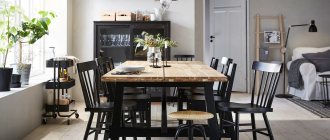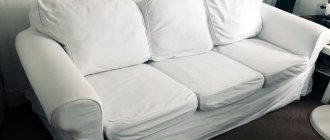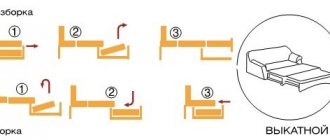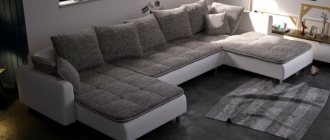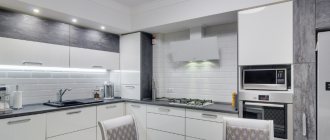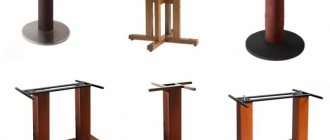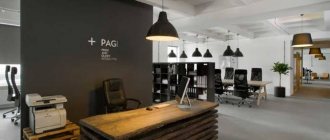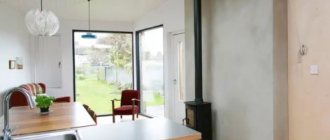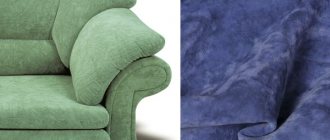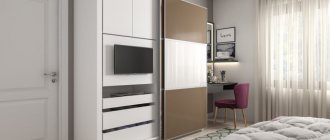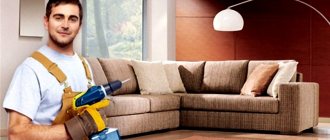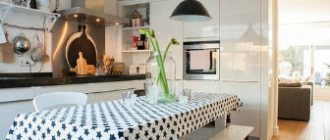The beauty and durability of soft interior items depends not only on the elaboration of internal mechanisms. It is also important what material is used for the upholstery: the time it takes to preserve the appearance of the furniture, ease of cleaning, color preservation and the overall perception of the sofa without the need for reupholstery depend on this. In this article, we’ll look at what fabric to choose for a sofa: we’ll talk about the categories/types of upholstery, their features, and selection nuances.
Upholstery fabric categories
The category allows you to understand the quality and operating features of the material. In addition, you need to remember that the higher the category, the denser and more expensive the fabric will be.
The strength of a fabric is mainly determined by the Martindale test, an abrasion test of a material. For the test, a figure of eight is drawn along the fabric - this allows you to use all sides of the fabric. Further in the classifications the strength indicator is indicated.
Let's take a closer look:
- 0 - selected for sofas that are rarely used. Durability is approximately 5,000 cycles. Category 0 includes cotton, scotchgard, and some light chenille fabrics.
- 1 - mainly not used for upholstery of furniture for the kitchen, children's room, chairs. Durability - up to 7,000 cycles.
- 2 are the same fabrics from category 1, having increased wear resistance and strength characteristics. Durability - 10,000–12,000 cycles. Characteristics of category 2 refer to flock, corduroy, jacquard.
- 3 - materials in this category have non-standard weaving, they have greater density and thickness. Durability - about 15,000 cycles.
- 4 - dense options like tapestry, bouclé chenille, printed suede. Durability - 17,000 cycles.
- 5 - this category contains fabrics that have a lining or an admixture of natural materials. Durability - 20,000–22,000 cycles.
- 6 - leather substitute, for example, eco- or nano-leather, Arpatek. Durability - 30,000–50,000 cycles.
- 7 - genuine leather. Typically, these premium fabrics feature intricate patterns and high durability. Durability - from 50,000 cycles.
Important!
The classification shows that the category determines the high cost and wear resistance of the product. However, remember that with proper and timely care, even for fabric of category “0”, the furniture will last no less efficiently and for a long time.
Description of chenille
As in the case of jacquard, chenille is not the material itself, but the yarn from which it is woven. Materials with chenille thread are strong, durable, pleasant to the touch and look beautiful. The main advantage of sofa upholstery is the huge number of color and texture options. The characteristics of the fabric provide mainly positive customer reviews.
Upholstery fabric: features of types
To understand what upholstery to choose for a sofa, you need to understand not only the categories, but also the types and characteristics of the fabrics themselves.
Genuine Leather
Leather furniture is expensive, but many rightfully consider leather one of the best solutions for upholstered furniture. In terms of reliability and service life, the fabric is superior to other types of materials. In office spaces or luxury hotels, leather sofas are more popular.
Leather is easy to care for, but it also has its own nuances, such as the high price, limited color palette, and inability to withstand long-term use at home in the presence of animals and children.
Velours
Velor upholstery is an excellent solution for bedrooms or living rooms, but is not suitable for children's rooms, as it is considered a good dust collector.
Velor is breathable, soft, does not stretch and is beautiful in appearance. But remember the need for frequent cleaning and the susceptibility of the material to abrasion. Do not use it for upholstery in the kitchen - it will be difficult to remove stains.
Flock
This combination of polyester and cotton with a velvety texture is very popular for furniture in different rooms. Flock is not suitable for the kitchen because it absorbs odors quite quickly and intensely. In general, the material is considered dirt-repellent, durable and easy to clean.
Sofas upholstered with flock are not afraid of pets: the strength of the material makes it difficult to tear. In addition, flock does not stretch, is antistatic, safe and does not require specific care. Cleaning is simple: a soap solution is enough to remove dirt.
Gozhka
The texture is of threads intertwined in a checkerboard pattern, creating a fairly dense fabric. Often wool or cotton, linen or acrylic polyester fibers are added to the weave. This connection of threads makes the material resistant to abrasion.
The matting is breathable, does not absorb foreign odors, does not sag during use, is hypoallergenic, does not require the purchase of additional covers, looks aesthetically pleasing and fits any style.
On the downside, it is not recommended for homes with pets, as claws contribute to the loss of the integrity of the material. The matting is susceptible to fading from the sun; it can only be cleaned dry; if the covers are removable, wash by hand in cold water.
Jacquard/thermal jacquard
A variety of patterns are possible. Thanks to wear resistance, density and resistance to fading, it is an excellent option for living rooms.
The fabric lasts a long time, maintaining its appearance; in addition to patterns, a variety of colors are possible, it looks luxurious and is most suitable for classic interiors.
The downside is damage from the claws of dogs/cats and water. Only dry cleaning method is available.
Scotchgard
A subtype of jacquard considered the most practical for upholstery. It is not subject to the accumulation of dirt because it is treated with special repellent compounds. It’s even good for a sofa that is used frequently and serves as a sleeping place.
Scotchgard is moisture-resistant, durable, looks beautiful, and is not a dust collector.
However, products with stock upholstery are not cheap.
Chenille
Pleasant to the touch and somewhat similar to corduroy. Not susceptible to fading due to sun or frequent cleaning. Wear-resistant and soft, repels odors, and is not subject to mechanical deformation.
One of the downsides is that cats’ claws can leave puffs on the chenille.
Microfiber
Simply put, it's faux suede. The material is tactilely pleasant, covered on top with waterproof and dust-repellent Teflon.
However, you should not choose sofas with microfiber upholstery if you have pets at home - there is a risk of getting claws on the upholstery. Cleaning is possible using a wet method.
Faux leather
The material is chosen by those who like leather products, but want to save money without losing any external characteristics. Eco-leather does not collect odors, which is why it is often used for upholstery of kitchen furniture.
The material is soft to the touch, inexpensive, quite resistant to external influences and easy to care for.
The downside is that it is not resistant to fire and cracks/scratches. In addition, eco-leather is quite sticky.
Arpatek
This is also a leather substitute, similar to natural fabric. It was first used as upholstery for car seats, then in the production of furniture for homes, offices, and hotels.
Unlike many other options, Arpatek is even resistant to animal claws.
The downside is the rather high cost of products with such upholstery.
Courtesan
Durable and fire-resistant material is suitable for furniture in any room, even if there are pets. Upholstery with anti-vandal effect can withstand various mechanical impacts. Courtesan is easy to care for, water- and dust-repellent.
The disadvantages are the high price and intolerance to chemical compounds.
Chenille or matting, which is better for the sofa?
Chenille is a dense, wear-resistant material with a pleasant velvety structure. This fabric has excellent consumer characteristics: it makes durable upholstery for furniture, high-quality curtains and drapes.
This fabric began to be woven in the USA about 200 years ago. Due to the special structure of the thread, it received the name “chenille”, which is translated from French as “caterpillar”. Indeed, chenille thread, braided with fluffy fibers for strength, resembles this insect.
Composition and production technology
Chenille thread is made in a special way: combed fluffy fibers are woven into the main smooth thread, after which the workpiece is tightly twisted, forming a thread with a dense fleecy structure. This thread is called chenille.
After twisting, the threads are dyed and sent to the weaving factory. There they are made into fabric by weaving chenille fibers into the warp threads. And the greater the number of chenille threads woven into the fabric, the denser and heavier the material will be.
In the production of chenille, both natural (cotton) and synthetic (polyester, acrylic, artificial viscose) materials are used, making the fabric durable and strong.
Properties
The weave of threads in chenille fabric can be different: satin, tapestry, twill or jacquard. The structure, appearance and consumer characteristics of the material depend on weaving. The most valuable is chenille fabric with jacquard weave.
Properties of chenille:
- does not shrink after treatment with water, but can become deformed when exposed to high temperatures;
- It is elastic, does not stretch well, does not wrinkle;
- draped in heavy, large folds;
- paints well and has a rich palette of shades, thanks to which it is very popular among designers;
- The color lasts a long time, does not rub off or fade.
Furniture with chenille upholstery looks expensive and noble. Due to the fact that multi-colored threads can be used in the manufacture of canvas, furniture covered with this material shimmers in different shades.
Types of chenille
According to its composition, chenille is divided into 3 types:
- Natural. The material contains more than 60% natural cotton fiber. It is environmentally friendly, hypoallergenic, pleasant to the touch and does not electrify. Its disadvantage is low strength.
- Artificial. The fabric is made from synthetic threads, cotton and artificial viscose. This chenille is stronger and more durable than natural, it is softer and more practical.
- Synthetic. The composition of the fabric is dominated by synthetic fibers - acrylic and polyester (more than 60%). The fabric is not very pleasant to the touch, but is durable and resistant to stains.
Source: https://71mebel.com/shenill-ili-rogozhka-chto-luchshe-dlya-divana/
Advantages of fabric upholstery
- Variety of colors and patterns. So, you can choose a material for a sofa that will fit most harmoniously into the interior of the room, will correspond to the design idea, and will be an excellent continuation or bright accent of the room.
- Protection of the interior of furniture. Here we mean that a high-quality coating repels dust, dirt, and water, which is good both for the material itself and for the mechanisms of the sofa/chair.
- Easy care. Almost all modern materials are easy to care for; rare ones have some restrictions and rules. All this eliminates the need to call dry cleaning, the long process of removing stains, and so on.
- Price. Most upholstery options can be purchased inexpensively. And today cheaper alternatives have been invented for expensive solutions.
Criteria for choosing fabric for furniture
Of course, the primary thing is how much you like the material. But the final choice can be made based on several criteria.
- Upholstery fibers.
In general, fabric can be composed of natural or synthetic fibers. Sometimes manufacturers combine them. When choosing, pay attention to the pros and cons of the fabric and its compliance with your request and conditions of future use. - Appearance and design of the room.
They must match. A standard classic version in minimalism or an almost ascetic solution in the Art Deco style, for example, will look strange. If the sofa is for a children's room, then it is worth asking the child for advice. - Density is an indicator of quality.
The higher it is, the more durable the upholstery will be. The minimum value for an excellent option is when the density is from 200g/m2. - Abrasion resistance.
In general, nothing lasts forever, and to one degree or another, any upholstery will be subject to abrasion. The question is, a month or 10 years after operation. - Fade resistant.
Exposure to direct sunlight and frequent washing do not have the best effect on the quality of some materials. If the room is on the sunny side, then you need to choose fabrics that are as “indifferent” to it as possible. - No harmful ingredients.
However, it is important to understand that there is a certain maximum permissible standard for the presence of harmful substances, at which there is no harm to the user’s health. - Breathability.
This characteristic is important so that the upholstery does not accumulate moisture and does not become a breeding ground for mold. Also, poor air exchange carries the risk of damage to the seams. - Easy to clean.
For example, synthetics are easier to clean than natural fabrics. With the latter you need to be careful and follow all the manufacturers' recommendations.
Features of the matting
Matting is a fabric with a large characteristic weave. Initially, this was made from the fibers of the cattail plant, which gave this type of texture its name. Now this name hides fabrics with a wide variety of composition, softness, and color.
IMPORTANT ! What makes devil matting distinctive is its special type of weaving, visually reminiscent of burlap. It is precisely because of the special surface texture that this material is easy to find among all other options.
Speaking about the features of this textile, it is worth stopping:
- On the roster. Traditional versions of the fabric were made exclusively from cotton, linen, wool or silk. Therefore, matting has a firmly established reputation as a natural material. In fact, if you pay attention to the composition of the options offered in the store, you will notice that this is not necessarily the case now. Almost always, this material has at least a small percentage of synthetics - this increases its strength properties. And sometimes there are options consisting of 100 percent acrylic, polyester or viscose. Be careful when purchasing.
- Densities. On average, this characteristic of matting is slightly worse than that of chenille. It fluctuates around 250–500 g/m2. But these are also very good values.
- Abrasion. Here the matting, on the contrary, surpasses its rival. This figure ranges for this type of textile from 20,000 cycles to 70,000. That is, despite its lower density, matting is stronger than chenille and, on average, lasts longer and more successfully.
- Health safety. If the textile contains wool, it is better not to use it in places where it will be in constant contact with small children. It may cause an allergic reaction. Matting without wool is completely safe. It, like chenille, does not absorb odors.
- Price. The cost of one linear meter of this fabric ranges from 300 to 900 rubles.
In a word, the main advantage of matting is its high strength, practicality, and relatively low price. The disadvantages of this fabric are the same as those of chenille. She is also not friendly with pets and accidentally spilled drinks.
Photo gallery
To choose a better fabric for upholstery, look at the photo from the gallery: how specific products look in the interior.
